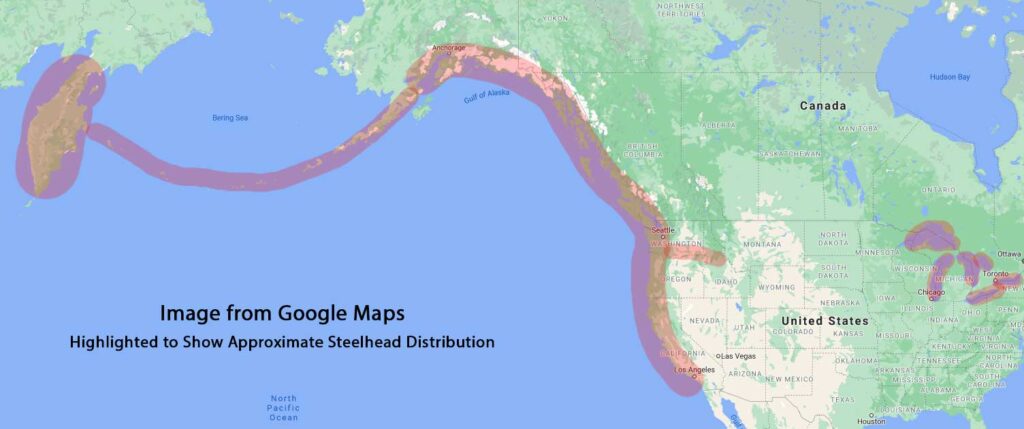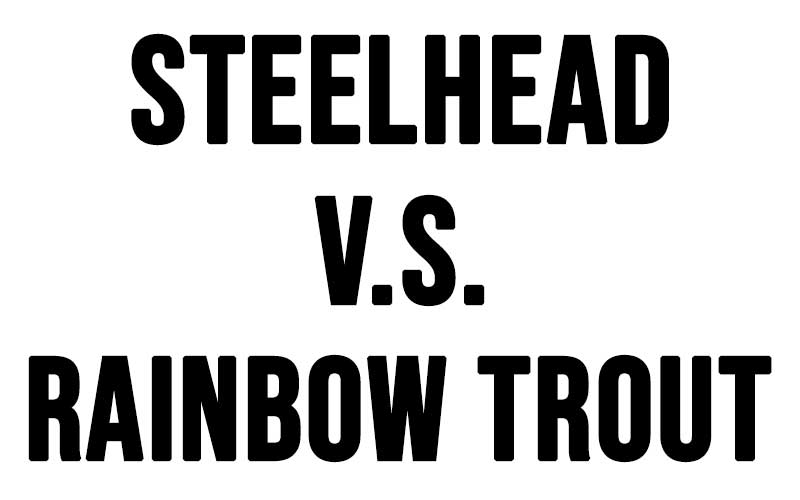It can be difficult for newer anglers to differentiate a steelhead from a rainbow trout. Heck, even experienced anglers might struggle with it. There are several key differences that distinguish a rainbow trout from the mighty steelhead. We’re going to give you a quick and easy answer.
Technical Classification
Both the Rainbow Trout and steelhead have the exact same scientific classifications, which means they are technically the same species. However, their lifecycle, location, and spawning habits vary greatly. Steelhead are born in freshwater and migrate to the ocean, eventually returning to freshwater to reproduce. Rainbow Trout spend their entire lives in Freshwater.
- Order: Salmoniformes
- Family: Salmonidae
- Genus: Oncorhynchus
- Species: Oncorhynchus Mykiss
Doesn’t this mean that they are the same thing?
Well…scientifically speaking yes. However, there are several differences in steelhead and rainbow trout diet, location, and spawning habits that cause the differences between the two fish.
Spawning Habits
The most significant difference between steelhead and rainbow trout is their lifecycles. Rainbow trout spend all of their life in freshwater. This means that their food chain is different; the size of the body of water is different, and the chemicals in the water are different. Steelhead start the first couple of years of life in freshwater, before migrating to seawater (Spoiler alert: It’s because their parents ended up there to spawn).
According to the US Fish and Wildlife Service, a male steelhead reaches maturity at just two years old, and a female steelhead reaches maturity at three years old. This doesn’t mean that they go to the sea right away however, they might spend several years in freshwater before migrating to the sea to mature.
Steelhead will then stay at sea for up to three years as they mature, feed, and grow. After their time at sea, Steelhead will return to freshwater (sometimes the same system they were born in) and spawn. Unlike salmon, who die after spawning, Steelhead can spawn multiple times in their lifetime.
Rainbow Trout on the other hand spend their entire lives living in freshwater. Because of this, they typically maintain their colorful patterns and don’t get the beautiful shiny silver pattern that steelhead do. When steelhead return to freshwater to spawn, they regain some of their rainbow trout-Esq colors with a pink stripe down the middle.
Size
Steelhead are usually between 24 and 30″ long as adults, however, there are always a few outliers and fish as long as 40+” have been caught. Their weight can vary greatly depending on how long they spend in freshwater after hatching, the availability of forage, competition from other steelhead, and more. Because steelhead can spawn more than once in a lifetime, many states have strict protections on harvesting steelhead. Alaska for example has a 36″ minimum on keeping steelhead, which ensures the majority of adults are released.
Rainbow trout are generally smaller on average than steelhead are. This is because they spend their entire life in fresh water and do not have the same access to the abundance of forage the ocean offers. Rainbows on average are between 10″ and 30″ and weigh anywhere from 1 to 10 pounds, with a 2-5 pound size more likely for a mature trout. Again, there is always an exception, and around the world, there have been monster rainbow trout caught. In fact, the world record Rainbow Trout is a 48pound, 42″ monster caught by Sean Konrad of Canada.
Forage
When Steelhead are young, they feed mostly on Zooplankton in the ocean. This microscopic food source is readily available and allows Steelhead to grow quickly. Once they reach adulthood, Steelhead forage on a variety of foods, including fish eggs, other fish (including smaller Steelhead), crustaceans such as Crayfish, and mollusks. Another food source for bigger Steelhead is mice. One of the most popular ways to fish for Steelhead on the fly at night is by stripping mouse pattern flies across the top of the water.
Rainbow trout have a slightly different diet than Steelhead because they spend their entire life in freshwater. Throughout most of their life, Rainbows eat small insects and invertebrate larva. You may have heard the term “match the hatch” which refers to fishing fly patterns that match the type of insects that are currently hatching. Many streams around the world have seasonal hatches of certain types of bugs, and when the hatch hits its peak, Rainbow Trout go into a full-on feeding frenzy. Of course, they do eat other meals as well, including but not limited to smaller trout, mice, frogs, earthworms, leeches, and fish eggs during the spawn.
Steelhead and Rainbow Trout Range
Steelhead are native to the North American continent west of the Rocky Mountains. Currently, their range is from Southern California, all the way up the Western border into Canada. The range extends from Canada to the Southern Coast of Alaska, and over to isolated locations in Eastern Russia. Steelhead are also found in the Great Lakes, Although many West Coast fisherman don’t view them as true Steelhead because they do not migrate to the ocean.

Rainbow Trout can be found in nearly every U.S. State. They have been successfully stocked in many lakes, rivers, streams, and ponds, and naturally reproducing populations have been successfully established. They are found around the globe sporadically, in places such as Japan, New Zealand, much of Europe, South America, and Asia. They vary in size regionally depending on the availability of food, quality of water, fishing pressure, and other factors.
Steelhead Fishing Lures / Techniques
Depending on the size of water and time of year Steelhead can be caught using a variety of techniques.
Bobber Fishing for Steelhead
Bobber fishing is one of the most common tactics for targeting steelhead in moving water and still water alike. The setup is pretty simple. Typically a slip bobber is set to a depth as close to the bottom as possible. Below the bobber lies a split shot or inline weight to help get the bait lower in the water column faster. A small circle hook with some form of bait attached completes the setup.
Bait can vary greatly, but some of the most common bait types include spawn sacks (steelhead/salmon eggs wrapped in a small piece of mesh), single large eggs/beads, and various soft plastics. You then cast the setup upstream, and let it slowly float downstream until you see a “bobber down”.
Spinners and Spoons for Steelhead
Spinners and Spoons are other excellent choices for targeting Steelhead in a variety of water conditions. Spinners are more common in shallower bodies of water such as rivers and streams, while heavier spoons are usually the choice in deeper pools and in the Great Lakes.
Many areas have restrictions on using treble hooks when fishing for Steelhead, so make sure to read up on the local regulations before accidentally using an illegal presentation. Spinners provide a large amount of flash and vibration. The flash represents the reflection of a passing baitfish, while the vibration can get the attention of a fish via it’s lateral line.
Spoons are usually heavier as they contain a higher concentration of dense metal and can get deeper than most spinnerbaits can. The irregular flashing and twisting of a spoon are what attracts Steelhead to the lure.
Fly Fishing Tactics
Fly Fishing is another popular tactic for targeting Steelhead. Just like with traditional spinning tackle, there are a variety of effective presentations. Swinging wet flies and streamers downstream can be effective for targeting fish that are held up in a current break or in deeper cuts and runs.
Another popular tactic is using small plastic beads that represent a single egg from Steelhead or Salmon. This is essentially the same setup as bobber fishing with a few modifications. Fly anglers use a light “strike indicator” to detect a bite rather than a heavy bobber. Below that, a small bead is attached to the tippet right above a small single hook. Again, utilizing a split shot can be very effective in getting the bait into the strike zone quickly.
Rainbow Trout Lures / Techniques
Rainbow Trout can be found in so many different bodies of water across the country that there really isn’t a lure or presentation that wont work. Spinners, bobber fishing, throwing jigs, casting crankbaits, and drifting live bait are some of the most common types of techniques. Remember, try to fish with a lure or bait that represents a natural or common food source in that body of water.
In lakes, Rainbow Trout can be found throughout the water column. One of the most common tactics is using a slip bobber set up with Powerbait. Powerbait is manufactured by Berkley and can be found in numerous colors and styles. If you’re just starting out, check out the Trout Dough Powerbait made specifically for trout fishing. Some of the most common Powerbait Colors include hatchery pellet (brown), white, chartreuse, pink, and orange.
